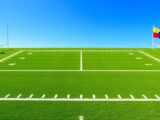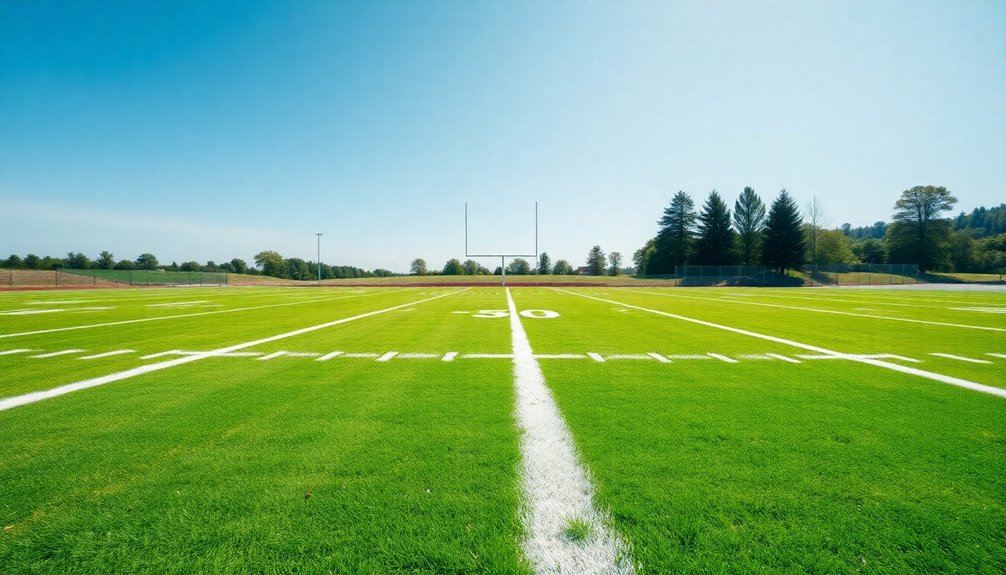
How Long Is a Flag Football Field? All You Need to Know
January 17, 2025A standard flag football field is 60 yards long and usually ranges between 20 to 30 yards wide. Most commonly, you'll see fields that are 30 yards wide and 70 yards long, including the end zones. Each end zone is typically 5 to 10 yards deep, which is essential for scoring touchdowns. Note that variations exist based on league specifications; for instance, NFL flag football fields measure 70 yards long. Understanding these dimensions can enhance your gameplay experience and strategy. If you stick around, you'll discover even more insights about field layout and safety considerations.
Overview of Flag Football Fields
When it comes to understanding flag football fields, precision is key. A standard flag football field measures 60 yards in length and varies between 20 to 30 yards in width, accommodating different team sizes and play styles. Each field features two end zones, typically ranging from 5 to 10 yards deep, which serve as vital scoring areas for touchdowns. The field is lined at 20-yard intervals from goal line to goal line, with specific markings like hash marks that help organize plays. You might notice variations in field dimensions based on league specifications, such as the NFL flag field measuring 30×70 yards and a standard field at 25×53 yards, adjusting to various age groups. Additionally, field dimensions and equipment requirements play a crucial role in ensuring that all players can compete safely and effectively. The global roots of soccer highlight the importance of standardized field sizes and rules in promoting fair play across different sports. The proper orientation of the field, ideally set up in a north/south direction, along with quality construction, plays a significant role in ensuring safety and ideal playing conditions for athletes. Understanding team composition guidelines is also essential for maintaining balance and competitive integrity within the game.
Standard Field Dimensions
Standard flag football fields are designed with precise dimensions to guarantee fair play and accommodate various team sizes. A standard flag football field measures 25 yards wide and 53 yards long, providing ample space for dynamic gameplay. Each end zone is typically 5 yards deep, adding to the overall length of the playing area and allowing for exciting scoring opportunities. In soccer, tactical flexibility is similarly vital for adapting to game situations and maximizing scoring chances. Additionally, the use of passing accuracy is essential in flag football for executing successful plays.
To help with measuring progress during the game, the field is marked with yard lines at 5-yard intervals. These yard lines not only provide a clear visual reference but also assist players in gauging their distance to the end zone. Additionally, hash marks are positioned 15 yards in from each sideline, helping players align their plays and spot the ball accurately. These dimensions make the standard flag football field versatile, ideal for smaller teams or restricted spaces. Whether you're playing in a park, school, or community center, understanding these dimensions can enhance your experience on the field. Moreover, similar to soccer, team composition plays a critical role in determining the dynamics of gameplay in flag football.
Variations in Field Sizes
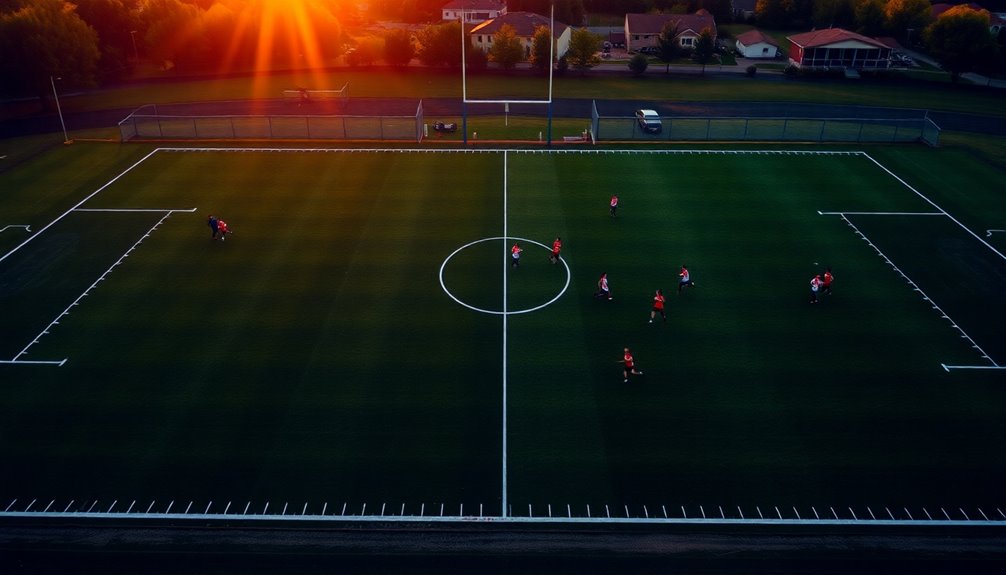
While the standard flag football field dimensions offer a solid foundation for gameplay, variations exist to cater to different leagues, age groups, and team sizes. These differences impact play styles and scoring opportunities, ensuring that everyone can enjoy the game.
Here are some key variations:
- NFL Flag Football: This field typically measures 70 yards long and 30 yards wide, including two 10-yard end zones, providing ample space for competitive play and larger teams. The dimensions of a soccer field can vary greatly depending on the level of play, similar to flag football. Additionally, like soccer, flag football emphasizes team dynamics that enhance player collaboration and strategy.
- Standard Flag Football: Measuring 53 yards long by 25 yards wide, this size is perfect for smaller teams and limited spaces, making it a popular choice for recreational leagues.
- Girls Flag Football: Fields may be larger, often reaching 100 yards long and 40 yards wide, promoting inclusivity and accommodating larger teams.
- Youth Leagues: Different age groups may use smaller fields, adapting the dimensions to suit younger players who benefit from shorter distances and simpler play styles.
Understanding these variations in field sizes helps you appreciate how flag football can be tailored to fit various needs, ensuring everyone has a chance to participate. Moreover, awareness of basic rules and structure in soccer can enhance your understanding of similar team dynamics in flag football.
Understanding End Zones
When you think about the end zones in flag football, you're looking at two essential 10-yard areas for scoring.
To score a touchdown worth 6 points, you must cross the goal line within these zones. The importance of goal areas in other sports, like soccer, highlights similar strategic elements in scoring. Understanding their dimensions and the scoring opportunities they present will enhance your gameplay strategy. Additionally, having a strong knowledge of proper form can significantly improve your chances of successfully navigating the end zones. The rules governing goal kicks in soccer also emphasize the significance of positioning and strategy in scoring scenarios.
End Zone Dimensions
End zones play a crucial role in flag football, each measuring 10 yards deep, which adds to the overall excitement of the game.
These areas are essential for scoring, as players must cross into the opponent's end zone to achieve a touchdown. Understanding the dimensions of end zones helps you strategize your plays effectively.
Here are some key points about end zones:
- Length: In a standard flag football field, each end zone is typically 10 yards deep, contributing to the total field length of 70 yards.
- Variations: Some versions of flag football may feature shorter end zones, often measuring just 5 yards deep.
- No Run Zone: There's a 5-yard area before each end zone called the no run zone, where offensive plays must involve passing.
- Yardage for Scoring: Knowing the yardage in these areas can help you plan your offensive plays and maximize scoring opportunities.
Scoring Opportunities Explained
Understanding the significance of end zones opens up a world of scoring opportunities in flag football. The end zones are typically 10 yards deep, providing essential space for players to score touchdowns. To achieve a touchdown, you need to advance the ball into the opponent's end zone, crossing the goal line. This is where your offensive plays become vital; they must be designed to exploit the space and create pathways for scoring.
After scoring a touchdown, your team has the option to attempt an extra point conversion from the 5-yard line or a 2-point conversion from the 10-yard line. This choice can greatly impact your game's strategy.
On the flip side, a safety, worth 2 points, occurs when your offensive team is stopped in its own end zone, highlighting the importance of defensive plays and end zone strategy.
Importance of Field Layout
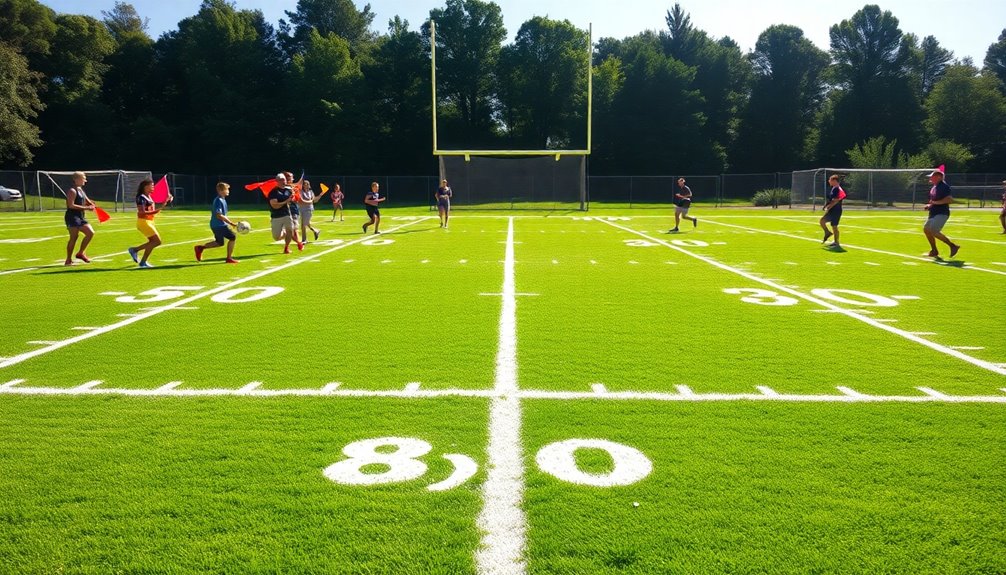
The layout of a flag football field is essential for creating an ideal gameplay experience and ensuring player safety. By understanding how to navigate the field's unique features, you can enhance your team's strategy and make smarter plays. Properly marked zones and field orientation not only facilitate accessibility but also keep the game moving smoothly. Additionally, understanding the importance of stoppage time can help teams manage their strategies more effectively during critical moments of the game. Regulation time ensures that teams have a fair opportunity to showcase their skills throughout the match. The strategic layout of the field can significantly impact defensive structures, allowing teams to create effective formations and capitalize on scoring opportunities.
Optimal Gameplay Experience
Creating an ideal gameplay experience in flag football hinges on the field's layout. A well-designed flag football field not only encourages player movement but also enhances engagement and strategy.
Here are four key features that contribute to an optimal gameplay experience:
- Scoring Areas: Each end zone extends 10 yards, providing clear scoring areas that boost offensive team chances to score touchdowns.
- No Run Zones: Located 5 yards before each goal line, these zones require teams to focus on passing plays, promoting skillful execution and strategic plays.
- Field Orientation: Proper layout minimizes safety risks, ensuring players can compete without unnecessary hazards while enhancing their overall experience.
- Markers for First Downs: With fields marked at 20-yard intervals, players can easily gauge distances, making it easier to strategize for first downs.
When you consider these elements, it becomes clear how essential field layout is for maximizing player engagement and maintaining a competitive atmosphere.
Safety and Accessibility
In flag football, safety and accessibility are fundamental aspects of field layout that can greatly impact player experience. A standard field measuring 30 yards wide and 70 yards long, including two 10-yard end zones, provides ample space for gameplay while guaranteeing safety.
It's essential to orient the field north/south to minimize sun glare, enhancing visibility and reducing the risk of injuries.
To guarantee safety, hard fixtures like trees and poles should be a minimum of 5 yards from the sidelines and 10 yards from the end lines. Regular inspections of field conditions are important to maintain compliance with safety regulations, helping to identify any potential hazards before they affect gameplay.
Clearly marked team boxes, positioned 2 yards off the sideline between the 20-yard lines, facilitate organized player management and access during games.
This layout not only promotes a safer environment but also contributes to smoother game flow. By prioritizing these aspects, you create a playing field that emphasizes safety, visibility, and accessibility, ultimately enhancing the overall experience for everyone involved.
Team Strategy Development
Flag football's field layout greatly shapes your team's strategy and approach during games. Understanding the dimensions and specific areas of the flag football field is vital for developing effective offensive strategies and defensive formations.
Here are four key aspects to take into account:
- No Run Zones: Located 5 yards before each end zone, these zones force you to rely on passing plays, adding complexity to your game plan.
- End Zones: Measuring 10 yards each, they create important scoring opportunities. Your team must strategize movement and positioning to capitalize on these chances.
- Midfield Line: This line serves as a significant marker for advancing the ball. It's important to devise plays that effectively utilize your four downs to cross this line and progress toward the end zone.
- Team Positioning: The layout influences how you position your players. Proper spacing and awareness of field dimensions allow for better plays development and exploitation of your opponents' weaknesses.
Safety Considerations
When planning a flag football game, safety considerations play a significant role in guaranteeing a secure environment for all players. Adhering to safety regulations is essential to minimize player injuries.
Make certain hard fixtures, like trees or poles, are at least 5 yards from the sidelines and 10 yards from the end lines. This distance helps prevent accidents and keeps your players safe from impact risks.
Additionally, cover any rigid fixtures with safety materials that have a thickness of at least 1/2 inch. Regular field inspections are fundamental to verify compliance with these safety margins, allowing for a secure playing environment.
Designated areas for team boxes are important too. Position them 2 yards off the sideline to reduce congestion and create clear spaces for players and coaches. This arrangement not only enhances safety but also guarantees smoother gameplay.
Equipment Required for Play
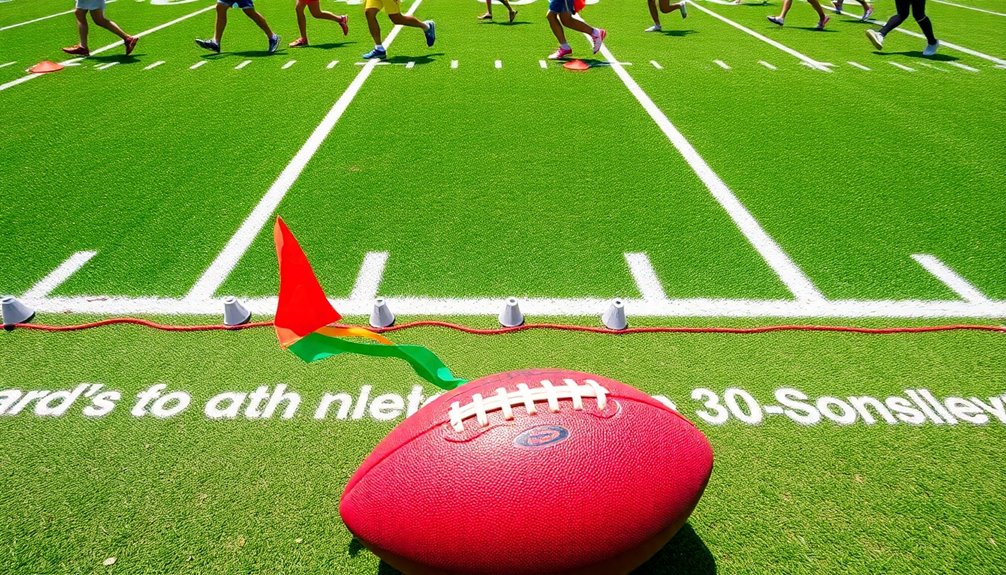
To enjoy a game of flag football, you'll need specific equipment that guarantees both safety and effective play. Understanding the essential flag football equipment helps enhance your experience on the field, which typically measures 30 yards wide and 70 yards long, including two 10-yard end zones. Here's what you need:
- Flags: Players must wear flags attached to their belts. These flags are vital as they replace traditional tackling, making the game safer.
- Protective Gear: Mouthguards are required for all players to minimize the risk of dental injuries during play. It's a simple way to protect yourself.
- Cleats: Cleats are recommended for better traction on the field. However, avoid metal cleats, as they're prohibited in most leagues to maintain player safety.
- Uniforms: You'll typically wear jerseys and shorts. Make sure your shorts don't have pockets to avoid penalties and injuries.
Having the right equipment not only prepares you for the game but also promotes a safer environment for all players involved.
Conclusion
In summary, knowing the dimensions of a flag football field helps you appreciate the game even more. Whether you're playing on a standard field or a variation, understanding the layout guarantees a fun and safe experience. Remember, the field is your canvas, and every play paints a thrilling picture of teamwork and strategy. So, grab your gear, gather your friends, and let the games begin—it's time to light up that field with your skills!

